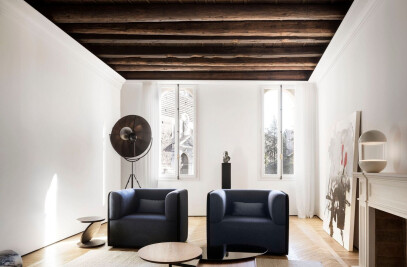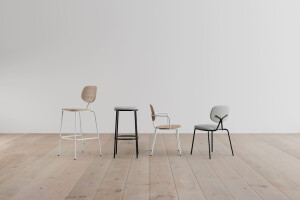In keeping with its commitment to guarantee quality and innovation, Knoll continues along that path begun a few years ago of reissuing of its historic, iconic pieces, bringing back to the catalogue a selection of updated legendary classics, such as those designed by Ludwig Mies van der Rohe, Florence Knoll, Eero Saarinen, Tobia Scarpa and Marcel Breuer.
The Pollock Arm Chair, originally produced in 1964-79, was reissued in 2014 for the US market by Knoll Inc., and is now being presented to the European public as well. “It has been more than half a century since the late Charles Pollock designed what was then called the Model 657, a minimal chair of polished chrome steel tubing and natural cowhide. The 657 blended comfort, functionality and, of course, style; Florence Knoll, seeing the design for the first time, declared it ‘gold.’ Known today simply as the Pollock Arm Chair, it initiated Pollock’s design relationship with Knoll; the designer went on to create the best-selling Pollock Executive Chair, which has remained in production since 1965. In fact, the Executive Chair has been so popular that it has in many ways overshadowed Pollock's first Knoll chair, in spite of the latter’s beautiful lines and simple way of responding to the user’s position. Today, Knoll is pleased to reintroduce the Pollock Arm Chair, a modern classic for the home.”
Pollock recalled the birth of the ‘657’ and the start of his collaboration with Knoll. “I was penniless, didn’t have a car and I was making my prototypes out of plumbing that I pulled out of an old, abandoned basement. I brought all these prototypes in [to Knoll] without an appointment and pushed them off the elevator and said, ‘I want to see Florence Knoll.’ Fortunately for me, [Senior Designer] Vincent Cafiero came out just by accident, and he said, ‘Who are you?’ I said, ‘I’m Charles Pollock.’ I had had a major article in Interiors, in a series of articles about Saarinen, Eames, and myself about three or four months before, and he had read that… So Cafiero said, ‘Look, this stuff is interesting. Why don’t you take this idea and throw this other idea into it?’ Eventually, between Vincent Cafiero and myself, I developed a quarter-inch scale model of a chair that was very, very similar to… the 657 chair. That was the beginning…. And the rest is history.”
The Pollock Arm Chair is a good example of the designer’s elegant use of a simple bent line, which in his chairs worked in three ways: for structure, a sense of solidity, and unique style. Pollock went on to design the bestselling Executive Chair, originally marketed as a “softer look” for executives, which resulted from Pollock’s unwavering commitment to a design object’s ease of use and durability. The metal rod of the frame that forms the chair’s structural rim is an excellent protection for the seat, providing a precious detail and an effective technical characteristic. The chair has become an icon of the modern workplace, displayed at the Metropolitan Museum of Art in New York, the Smithsonian in Washington and the Louvre in Paris.
In Pollock’s words: “Give them something that never goes out of style, that never wears out.” For him, timeless beauty comes about through an understanding of the total user experience. The approach has proven its worth; both chairs are as relevant and striking now as they were in the 1960s, and equally loved in the home or office.
Charles Pollock passed away in 2013, at the age of 83. He is remembered for his commitment to the people for whom he designed during the course of his career.
“It starts as a thought, and then becomes an idea, something I might think about for years. When the time is right, I express it on paper, usually as a simple line in space. Finally, it takes shape.” – Charles Pollock (1930-2013)



















